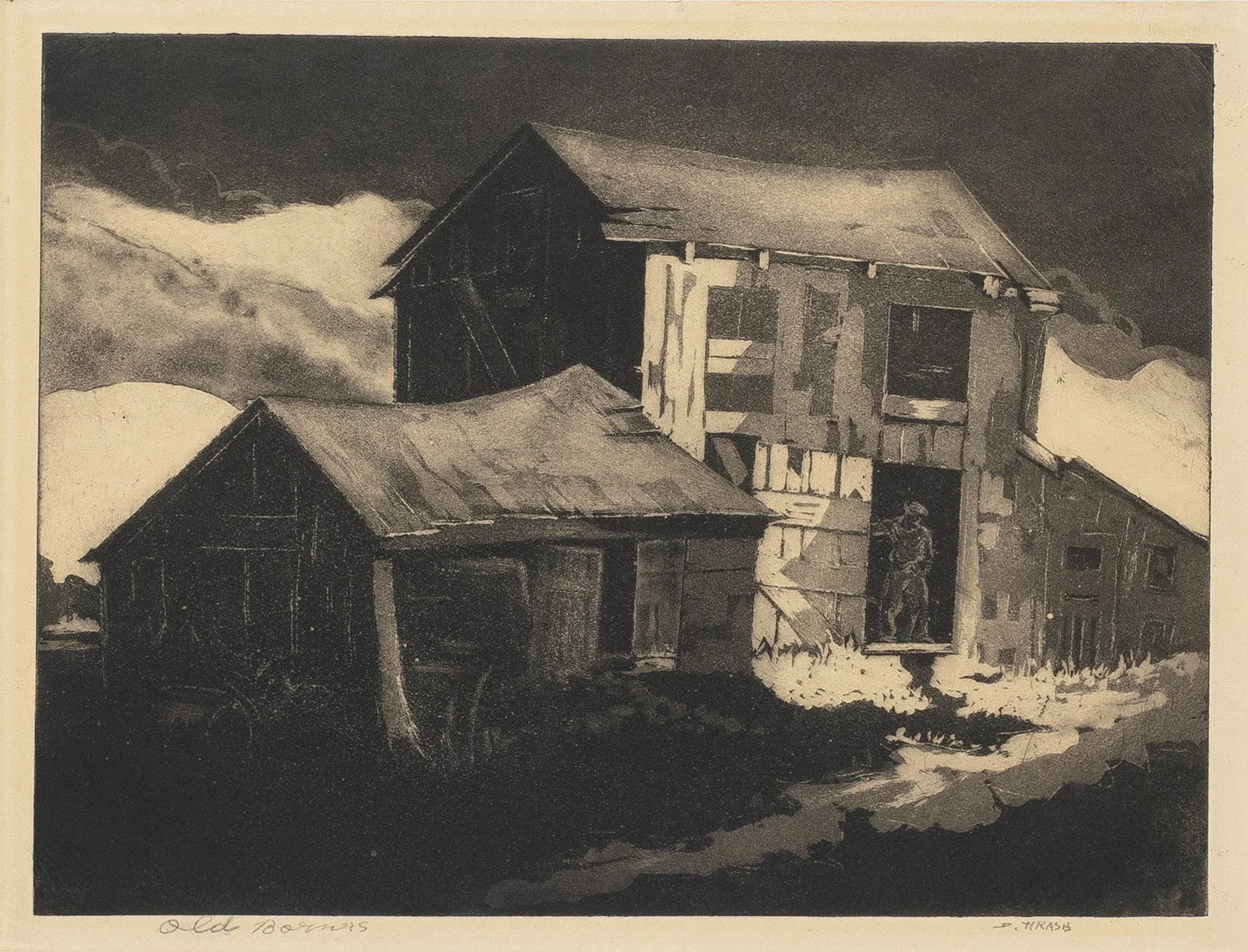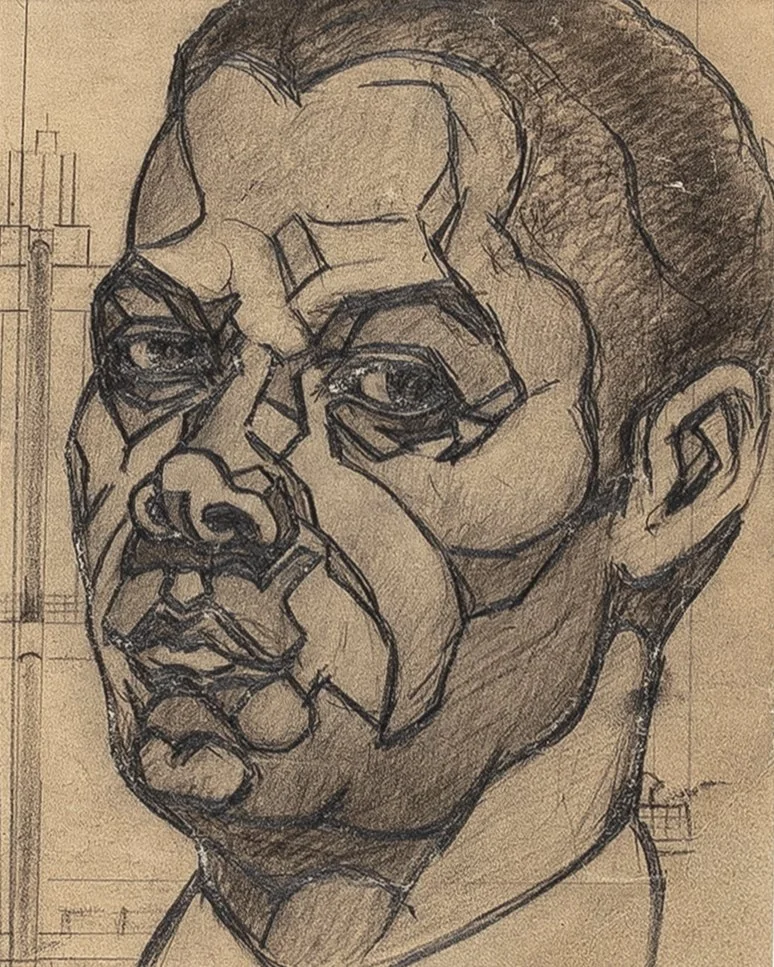
Dox
Thrash
(1893-1965)
Old Barns
1937-1938
etching and aquatint
9 x 12 inches (image), full margins
signed and titled in pencil
Illustrated: Dox Thrash, An African American Master Printmaker Rediscovered, John Ittmann, Philadelphia Museum of Art, p. 99.
“Carborundum is the trade name of an industrial product traditionally used to clean lithographic stones. When used on a copper plate, its hard, granular crystals create an overall pitted surface. The artist then scrapes and burnishes the image on the plate so that the pitted areas will hold ink and print darker than the smooth, burnished sections, thereby creating strong contrasts”
— Tomlinson, Glenn C., and Rolando Corpus. “A Selection of Works by African American Artists in the Philadelphia Museum of Art.” Philadelphia Museum of Art Bulletin 90, no. 382/383 (1995): 10. https://doi.org/10.2307/3795505.
Self Portrait
1930-1935
graphite and brown pencil on paper
6-7/8 x 5-3/8 inches
unsigned
Born in Griffin, Georgia, in 1893, Thrash came of age in a segregated South. Following the Great Migration north n 1911, he traveled to Chicago, enrolling at the School of the Art Institute, where he received formal training while supporting himself through a range of jobs. After serving in World War I, Thrash settled in Philadelphia, where he would live and work for the rest of his career. It was there, in the 1930s, that he became associated with the Works Progress Administration (WPA) Federal Art Project. At the Philadelphia Print Workshop, Thrash, together with James Lesesne Wells, Raymond Steth, and others, helped cultivate a collaborative community of Black printmakers and artists. It was within this environment that Thrash co-invented the carborundum mezzotint process, a technique that employed industrial carborundum grit to produce luminous, velvety tonal ranges in printmaking. This innovation not only expanded the possibilities of the medium but also allowed him to render subjects with a tactile richness and emotional gravity rarely seen in American prints.
Thrash’s imagery is deeply rooted in the Black experience. His portraits of African-American laborers, domestic scenes, and sensitive depictions of women exude dignity and quiet strength. At the same time, his landscapes and urban views capture the resilience and aspiration of African-American communities navigating the Great Migration, economic depression, and the wartime years.
Though grounded in realism, Thrash’s work is far from mere documentation. His carborundum prints harness light and shadow in ways that elevate his subjects, granting them a presence and gravitas aligned with the ambitions of the Harlem Renaissance and its call for positive Black representation. He belonged to a generation of artists, alongside figures like Charles White, Elizabeth Catlett, and Hale Woodruff, who sought to craft images that dignified Black identity while engaging in formal experimentation.
Thrash’s legacy is twofold: as a technical innovator in printmaking and as a cultural witness, inscribing African-American experience into the visual record of modern art. His prints remain highly sought after by collectors not only for their beauty but also for their historical importance. In 2001, a major retrospective of his work was held at the Philadelphia Museum of Art. Dox Thrash: An African American Master Printmaker Rediscovered, reignited institutional engagement with Thrash’s work and underscored the breadth of his practice
Selected Exhibitions
Contemporary Negro Art, Baltimore Museum of Art, MD, 1939
Exhibition of the Art of the American Negro (1851-1940), Tanner Art Galleries, Chicago, IL, 1940
First Annual Exhibition on Art, Pyramid Club, Philadelphia, PA, 1941
WPA Prints, Philadelphia Museum of Art, PA, 1942
Exhibition of Graphic Arts by DOX THRASH, Howard University Gallery of Art, Washington, DC, 1942
DOX THRASH: Carborundum Prints, Smithsonian Institution, Washington, DC, 1948
Afro-American Artists, 1800-1969, School District and Museum of the Philadelphia Civic Center, PA, 1969
DOX THRASH, James A. Porter Gallery, Washington, DC, 1970
Two Centuries of Black American Art, Los Angeles Museum of Art, CA, 1976
WPA and the Black Artist: Chicago and New York, Chicago Public Library, IL, 1978
Impressions/Expressions: Black American Graphics, Studio Museum in Harlem, New York, NY, 1979
Unbroken Circle: Exhibition of African American Artists of the 1930's and 1940's, Kenkeleba House, New York, NY, 1986
The Great Migration: The Evolution of African American Art, 1790-1945, Taft Museum of Art, Cincinnati, OH, 2000
Dox Thrash: An African American Master Printmaker Rediscovered, Philadelphia Museum of Art, PA, 2001
In Search of Missing Masters: The Lewis Tanner Moore Collection of African American Art; Woodmere Museum of Art, Philadelphia, PA, 2009
As We See It: Selected Works from the Petrucci Family Foundation Collection of African American Art, African American Museum in Philadelphia, PA, 2015

